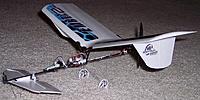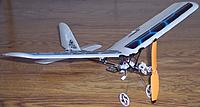Archive for May, 2012
-
 Views: 352
Views: 352
Ember 2 Canard with AR6400 Brick, parkzone linear servo for rudders, GWS wheels, and 120mah LiPo. Elevator deflection downward removed after flight. -
 Views: 299
Views: 299
Stock 6mm motor and propeller thrust angle tweaked for straight flight. CG location just behind leading edge of wing at root. -
 Views: 320
Views: 320
Rudders braced with carbon fiber and all held in place with clear tape. Note reinforcement music wire on elevator. -
 Views: 308
Views: 308
Motor includes some down thrust per the stock airplane. -
 Views: 276
Views: 276
Ember 2 Canard still fits inside stock foam tray and cardboard box with minor trimming by elevator, Brick, and battery mount locations. -
 Views: 299
Views: 299
Ember 2 Canard design changed to full-flying canard early February 2014. -
 Views: 261
Views: 261
full-flying canard -
 Views: 243
Views: 243
Details showing balsa and plywood support for full-flying canard.
Comments (1)
Add Comment
-
 Views: 305
Views: 305
February 2011. AR6400 Brick, rotary servo, taped on ailerons, larger foam wheels, stock 6mm motor and propeller. -
 Views: 282
Views: 282
August 2011. Harbor Freight wing on close out, wing angle of incidence reduced, UM P-51 gearbox and motor, GWS5030 propeller, two Linear servos from Hobby King, and GWJ Universal prop saver. -
 Views: 271
Views: 271
Aileron control horns from Hobby King. -
 Views: 296
Views: 296
December 2011. Ailerons using stock wing, torsion rods, and GWS 25mm wheels. -
 Views: 289
Views: 289
Placement of Hyperion 180mah LiPo behind Brick to balance 8.5mm motor. -
 Views: 293
Views: 293
Independent ailerons permit reflex and camber settings with DX7 transmitter. Flies with minimal throttle to pitch coupling with this wing angle of attach and CG.
-
 Views: 330
Views: 330
GPS-7 gearbox with 7mm SS Red end bell motor, GWS5030 prop reduced to 4.5", wings staggered to balance lift with CG location, wheels from foam plate for prop clearance. -
 Views: 242
Views: 242
7.8:1 ratio Helicopter gear drive installed with 7mm SS Red motor, GWS6050SF prop still under-loading motor. Shown before lengthening landing gear wire. Weight of changes not justify keeping. -
 Views: 236
Views: 236
Back to GPS-7 gearbox, now with GWS4530 prop and GWS wheels. -
 Views: 258
Views: 258
Removing stagger from wings forced battery relocation to just in front of wing leading edge. Simple flat foam plate supports of top wing are light, strong, and taped in place. -
 Views: 200
Views: 200
Second wing moved to below the fuselage for a lower profile. Motor thrust angle now imparting more down thrust simply do to change in wing location. -
 Views: 171
Views: 171
Original foam tray carved to accept updated Ember 2 biplane. -
 Views: 178
Views: 178
Fits compactly yet expresses ingenuity.
-
 Views: 268
Views: 268
Albatros mono-wing racer. Only about 21 grams with light detailing, 7mm motor, 3-channel Brick. -
 Views: 197
Views: 197
Fits nicely in Ember 2 foam tray and cardboard box. -
 Views: 240
Views: 240
Wing reinforced with 0.020 inch music wire that is taped into place. -
 Views: 236
Views: 236
Closer to an Albatros with the upper wing finally added. Kept it low to the fuselage for increased strength and lighter weight. Flew well. -
 Views: 220
Views: 220
Triplane in anticipation of the Fokker DR1 from Flyzone. Really slowed the flight down and increased the rudder effectiveness. -
 Views: 246
Views: 246
Still fits the Ember 2 foam tray which now resides in a taller cardboard box
-
 Views: 284
Views: 284
Fox with dihedral added, GWS6050SF prop cut down to 5 inches, GWJ Universal prop saver. -
 Views: 315
Views: 315
GWS rubber nose cone, GPS-8 gearbox and motor installed with balsa-plywood-screws. -
 Views: 438
Views: 438
Fuselage hollowed, GPS-8 gearbox and motor, AR6400 Brick. -
 Views: 312
Views: 312
Weight without 320mah battery and nose cone is about 49 grams. -
 Views: 239
Views: 239
April 10, 2013: Fire Fox wing installed on Multiplex Fox for added wing area. EPP foam material. -
 Views: 392
Views: 392
Fox versus Fire Fox wing comparison. -
 Views: 224
Views: 224
Fox flies just as well with larger wing. Might even thermal easier and fly a bit floatyer.








